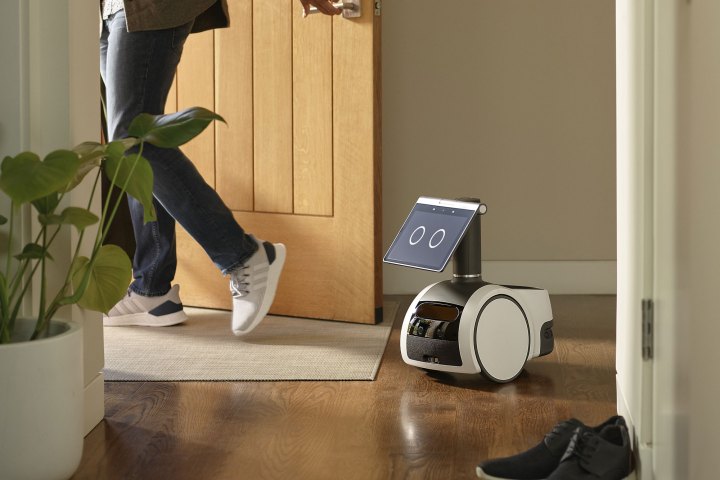Amazon today announced Astro, a helpful, adorable little robot for use throughout the home. It was without a doubt the most polarizing announcement at Amazon’s fall event. Unlike many other devices we refer to as “robots,” Astro is truly a robot. It navigates around the home on its own and even has a sort of personality. The artificial facial expressions almost guarantee some level of bonding is going to take place.
We’ve pointed out countless times how many of today’s robot vacuums fail at avoiding obstacles inside of the home. Navigation and collision avoidance is also a challenge for robot lawn mowers. However, Amazon promises efficient navigation through the home with Astro, and I have to say I believe it will deliver. I don’t doubt that Astro will move throughout your household with ease, especially given the navigational technologies in play, namely, SLAM (simultaneous localization and mapping).
Astro can ‘see’ your home
Despite the large eyes on its display, Astro doesn’t actually see what’s in front of it, at least not in the way you might think. SLAM technology allows Astro to pick up on walls and obstacles in front of it, even those that weren’t there moments before.

It’s not an untested technology. Some robot vacuums make use of this technology to navigate throughout the home (although some of them use lidar instead.) The ability to detect new items and dodge around them means Astro can be used in a child’s playroom. Even scattered toys won’t interfere with its navigation, although I can’t imagine a Lego rolling up inside it will be good for Astro. Can robots get heartburn?
Astro will be able to recognize family members, too, thanks to another feature called Visual ID. This means Astro can seek out a specific member of the family to pass along a message or even deliver a package to if you’ve placed something in its cargo bin.
SLAM technology works by tracking specific points through multiple successive frames using a single 3D camera, but multiple cameras can provide more depth perception. This is one of the reason that robot vacuums that utilize SLAM technology are often better at avoiding obstacles in their path. We know Astro has multiple cameras, although it isn’t clear how many are always facing forward, but there is at least one additional telescoping camera on top of the device.
Astro can learn your home
There is a lot of evidence that Astro will also learn the layout of your home. Since the user can set “out of bounds” zones where Astro can’t go, it implies the existence of some sort of smart mapping feature. If you manually place Astro inside one of these zones, it will immediately try to leave.
Astro processes a lot of its information on-device, which means it doesn’t necessarily need Wi-Fi to operate. The lack of Wi-Fi won’t mean Astro can no longer navigate intelligently; in fact, this feature allows it to more quickly shift direction and respond to new inputs because it isn’t introducing additional lag while waiting on a signal to return from the cloud.
The robot has both active and passive braking capabilities. If a pet runs in front of Astro, it will stop without being told. This fast response isn’t just a safety feature — it speaks to how quickly Astro can process information and respond to obstacles.

If Astro can handle the sudden appearance of a pet or a child, surely it can navigate around a table leg with ease. The device also has other sensors built into it, but the technical details have not all been released yet.
According to Amazon, you can send Astro to check on specific rooms and people. It can even function in a patrol mode where it makes passes around the home looking for trouble, and can also respond to unfamiliar sounds like breaking glass or the beeping of a smoke detector.
Learning your home is about more than just the layout. A device like this also needs to know the household. Astro can learn the people who are supposed to be in the home and send alerts if it sees an unfamiliar person.
With the periscope camera on top of Astro, you can check on things on your countertops or use it to ensure you turned off the stove. Amazon showed Astro moving with this camera deployed, but the robot won’t move if the camera is deployed beyond its lowest setting.
Seeing is believing
With all of this in mind (the proven efficiency of SLAM technology, on-board processing, and Astro’s rapid response times), I am convinced this little robot will be able to avoid obstacles. Its larger wheels mean it isn’t likely to get tangled up trundling over wires, either. Although only time will tell, I’m excited to see how this robot pushes the boundaries of in-home navigation. Maybe the effects will even trickle down to more efficient robot vacuums and mops.



